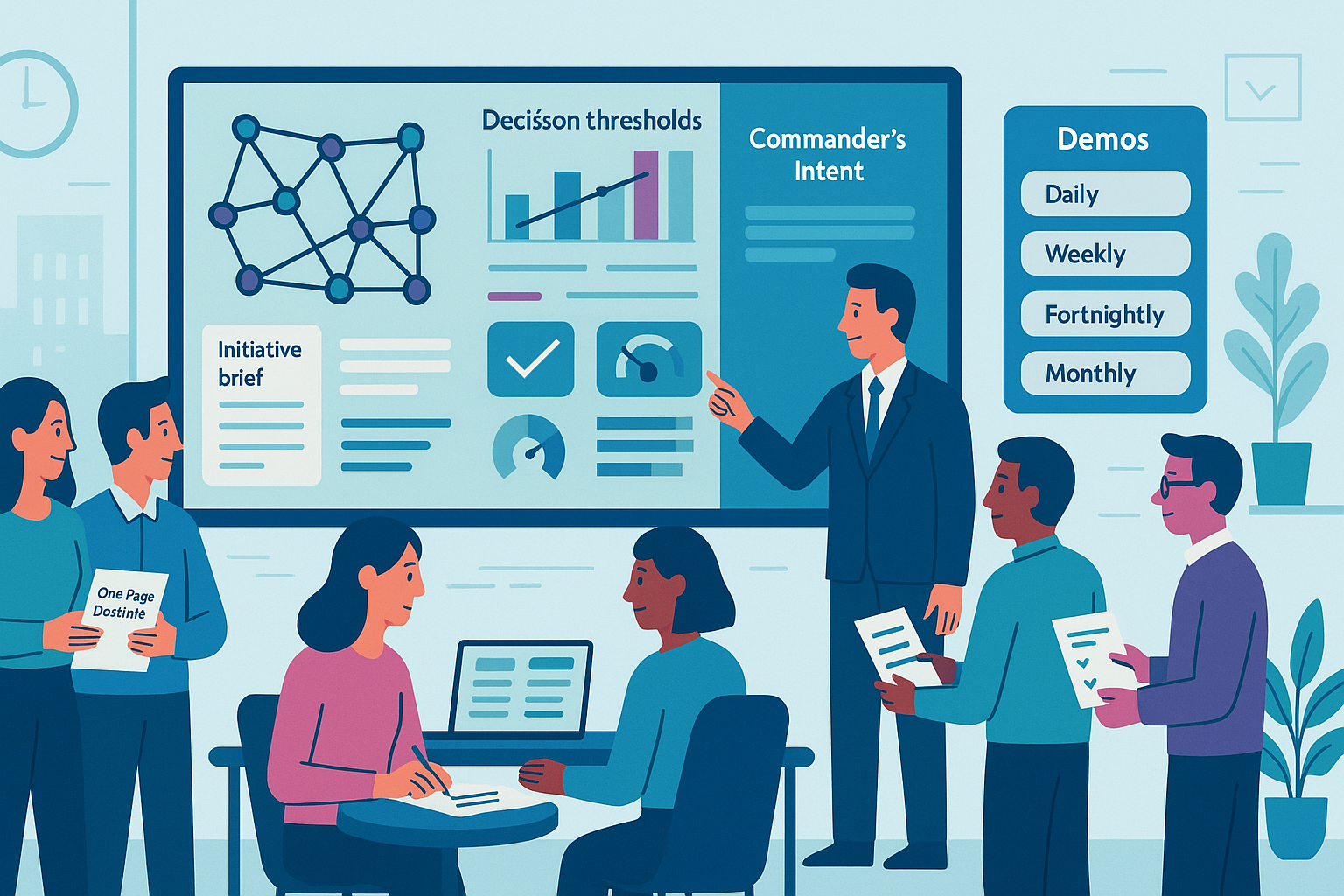
Shared Consciousness, Empowered Execution [Leaders' Guide]
Introduction
If your team moves fast but trips over itself, you lack shared consciousness. If your plans look tight but decisions queue behind you, you lack empowered execution. You need both. This guide shows you how to build them deliberately, measure them, and keep them tight as you scale.
What “Shared Consciousness” and “Empowered Execution” Really Mean
Shared consciousness is a living, shared understanding of reality across teams. It is built from common purpose, transparent information, and consistent language. It allows people to predict each other’s moves without waiting for permission.
Empowered execution is disciplined autonomy. People closest to the work make decisions within clear intent and guardrails. They move fast without creating chaos because context and constraints are explicit.
Why it matters now
Complexity is up. Interdependencies are non‑linear. Work is distributed. Traditional command-and-control cannot keep pace. You need a system that scales cognition and action at the same time. Shared consciousness gives alignment. Empowered execution gives speed. Together they produce outperformance.
The Operating System: Core Principles
You do not get this by accident. You design it. Principles below form the backbone of your operating system.
- Intent over instruction: Leaders state why and what, not step-by-step how.
- Transparency by default: Information is open unless there is a clear, legal reason to restrict it.
- Small teams, strong links: Keep units small and accountable. Connect them through robust shared rhythms.
- Written-first communication: Capture decisions, context, and assumptions in writing. Reduce memory risk.
- Decisions where information lives: Push decision rights to the edge with clear thresholds and guardrails.
- Learn in public: After-action reviews and decision logs are open. Learning compounds across the organisation.
Define Shared Consciousness: Precise and Practical
Shared consciousness is not vague alignment. It is a concrete state with observable behaviours:
- People can explain the strategy, current priorities, and key risks without a slide deck.
- Teams anticipate cross-functional impacts before they ship.
- Information is fresh, findable, and consistent across tools.
- Decisions reference doctrine, not personal preference.
Build Shared Consciousness: Step-by-Step
You cannot “announce” shared consciousness. You engineer it. Follow these steps.
- Publish a one-page intent and doctrine
Capture purpose, strategic aims, and how we win. Add operating doctrines such as decision speed targets, quality bars, and risk appetite. Keep it to one page. Make it the first page of your wiki. - Establish a single source of truth
Create a central, searchable wiki for strategy, priorities, dependencies, and playbooks. No parallel versions. Link everything. Use stable URLs and consistent naming. Make updating it a performance expectation. - Standardise language and artefacts
Define common terms for initiatives, milestones, and metrics. Provide templates for briefs, decision records, and after-action reviews. Ban bespoke formats. Reduce friction and misinterpretation. - Map critical dependencies explicitly
Build a dependency map that lists upstream and downstream relationships for top initiatives. Use simple visualisations and maintain owners. Review weekly so surprises are caught early. - Run a disciplined operating rhythm
Use clear cadence and purpose. Keep the minimum set of meetings that creates maximum shared understanding.
- Daily standups: 15 minutes, plan the day, surface blockers and cross-team impacts.
- Weekly priorities: 45 minutes, confirm what matters this week, review dependencies and risks.
- Fortnightly demos: 60 minutes, show working outcomes. No slide theatre. Make it concrete.
- Monthly strategy sync: 90 minutes, recalibrate against goals, adjust bets, retire zombies.
- Create liaison roles for high-friction interfaces
Nominate trained liaisons between functions with chronic misalignment. Rotate quarterly. Their job is to translate, connect, and de-risk handoffs. Write a short charter for each liaison. - Make decision logs mandatory
Every material decision gets a lightweight record: context, options considered, decision, rationale, owner, date, guardrails. Tag them and link from relevant pages. This institutionalises memory and reduces re-litigation. - Practice decision and crisis drills
Quarterly fire drills. Simulate failures and late-breaking constraints. Test how information flows and how decisions escalate. Capture learnings in the open. - Implement a shared dashboard wall
Build one dashboard that shows a small set of leading and lagging indicators across teams. Include current priorities, dependency status, delivery health, capacity, and risk. Display it in all relevant rooms and channels. - Reward transparency and constructive dissent
Praise those who surface risks early and challenge assumptions with evidence. Penalise information hoarding, sandbagging, and passive acceptance of broken processes.
Empowered Execution: Guardrails, Not Guesswork
Autonomy without clarity is negligence. You need explicit guardrails that enable speed and protect standards.
- Commander’s intent: For every initiative, write a 5-7 line intent. State purpose, desired effect, non-negotiable constraints, unacceptable outcomes.
- Decision rights matrix: Define who decides, who must be consulted, and who must be informed for key decision types. Keep it to one page per team.
- Thresholds and triggers: Set quantitative caps for when to escalate. Examples include budget variance, risk scores, client impact, and safety limits.
- Two-way door decisions: Default to decide-and-iterate when reversibility is high and blast radius is low.
- 70 percent rule: Make decisions when you have 70 percent of the information and the cost of delay is higher than the cost of a reversible mistake.
- After-action reviews: Run short, blameless reviews within 72 hours of material events. Convert insights into doctrine updates.
Leadership’s Role: Set Pace, Remove Friction
Leaders must change their behaviour first. Your team copies what you do, not what you say.
- Model transparency: Publish your own decision records and weekly priorities.
- Remove constraints: Identify top three blockers creating latency between teams. Fix them personally.
- Calibrate risk: State the acceptable miss for speed. Show where quality is non-negotiable.
- Coach judgment: Review decisions against intent, not outcome alone. Teach pattern recognition.
- Protect focus: Cancel meetings that do not produce shared understanding or decisions.
Operating Cadence: The Minimum Effective Dose
A tight rhythm multiplies context and accelerates execution. Keep it lean and reliable.
Weekly
- Leadership sync: 30 minutes. Confirm strategic intent, shifts, and material risks. No status theatre.
- Priorities and dependencies: 45 minutes cross-functional. Who needs what from whom by when.
- Demo hour: Show work. Invite adjacent teams. Capture learnings immediately in the wiki.
Monthly
- Strategy recalibration: Review bets, resource allocation, and capacity. Kill or double down.
- Capability review: Identify skill gaps and system weaknesses. Commit to fixes with owners.
Quarterly
- System drill: Stress test your escalation tree, comms channels, and decision thresholds.
- Doctrine refresh: Update definitions, templates, and guardrails based on what actually happened.
Essential Artefacts: Make The Invisible Visible
Clarity lives in artefacts. Build the following and keep them current.
- Team README: Purpose, scope, decision rights, interfaces, and ways of working. One page.
- Initiative brief: Intent, outcomes, measures, dependencies, timeline, and guardrails.
- Dependency register: Current cross-team commitments, with dates and owners.
- Decision log: Lightweight records with tags. Searchable and linked.
- Operating model map: How value flows across teams. Simple and current.
- Runbooks: Step-by-step responses for known events. Keep them near where work happens.
Metrics That Matter: Measure Cognition and Action
You get what you measure. Track a balanced set of signals for shared consciousness and empowered execution.
Shared consciousness indicators
- Information freshness: Percentage of critical pages updated within the defined SLA.
- Cross-team latency: Average time to get a response for dependency requests.
- Duplicate work: Count of collisions discovered per month. Trend should fall.
- Strategy comprehension: Quarterly pulse on whether people can state strategy, priorities, and risks.
- Decision visibility: Percentage of material decisions captured within 72 hours.
Empowered execution indicators
- Decision cycle time: Time from trigger to decision for defined decision types.
- Rework rate: Percentage of work redone due to avoidable misalignment.
- Escalation effectiveness: Resolution rate within target times for escalated issues.
- Time-to-value: From start to first value delivery. Prioritise reducing this without quality loss.
- SLA adherence and defect density: Quality remains stable as speed increases.
Build a Diagnostic Heatmap
Turn metrics into action with a simple heatmap. Score each indicator red, amber, or green. Review weekly at leadership and cross-functional forums. Ask three questions:
- What is red now and why
- What is trending worse and why
- What do we stop, start, or change this week
Tooling That Enables, Not Distracts
Technology supports the system. Do not hide bad behaviours with tools. Choose a focused stack and use it properly.
- Async collaboration: Microsoft Teams or Slack. Channels map to value streams, not departments. Use threads. Ban direct messages for work decisions.
- Wiki: Confluence or Notion. Enforced templates and ownership. Weekly freshness checks.
- Work management: Jira, Linear, or Asana. One system of record. No shadow trackers.
- Whiteboarding: Miro or FigJam. Link artefacts back to the wiki.
- Dashboards: Power BI, Tableau, or Looker. Aggregate a small set of leading and lagging indicators.
- Decision log: Lightweight system that can be a dedicated page per team with tags and indexes.
Rituals and Behaviours That Cement The System
Rituals make the culture real. Keep them short, regular, and purposeful.
- Pre-reads for decisions: Circulate two-page briefs 24 hours before decision meetings.
- Demo days: Ship or show something every two weeks. Invite dependent teams.
- Swarm sessions: Time-boxed cross-functional problem solving when latency builds.
- Office hours: Leaders offer weekly drop-in slots for fast escalation.
- Open after-action reviews: Anyone can attend. Publish learnings and doctrine changes.
Failure Modes and Anti-Patterns to Avoid
You can break this system easily. Watch for these patterns and act fast.
- Centralised approvals: If everything waits on a few people, you will die in queues.
- Information hoarding: If people win by guarding knowledge, shared consciousness collapses.
- Vanity metrics: If you track what looks good rather than what drives outcomes, reality drifts.
- Over-meeting: If people cannot do deep work, execution quality falls.
- Autonomy without intent: Freedom without clear outcomes creates rework and risk.
- Tools without rules: New software does not fix broken behaviours.
- Hero culture: If success relies on a few heroes, you are fragile.
- Rhetorical alignment: Smiles in the room, divergence in the work. Check the artefacts, not the chatter.
A Short Case Example
A 220-person B2B SaaS company faced late releases, client escalations, and finger-pointing across Product, Engineering, and Customer Success. They introduced a one-page doctrine, a shared wiki, a dependency register, fortnightly demos, and decision logs. Decision cycle time for P1 product issues dropped from 72 hours to 16 hours. Duplicate work incidents fell from 9 per month to 2 in eight weeks. Time-to-value for enhancements improved by 31 percent. Defect density held steady. The biggest win was qualitative: leaders stopped being gatekeepers and became context amplifiers. The system did the heavy lifting.
Use the 6Ps to Align the Whole System
Use a big-picture pass with the PerformanceNinja 6Ps to ensure your operating system is coherent.
- Purpose: Publish a plain-language strategy and intent. Review monthly and on major shifts.
- People: Train on decision-making, doctrine use, and cross-functional communication. Build liaison capability.
- Proposition: Tie empowered execution to the value you promise customers. Protect quality thresholds.
- Process: Lock in the operating rhythm, decision logs, and dependency management.
- Productivity: Track cycle times, rework, and time-to-value. Reward transparency and speed with quality.
- Potential: Run a lightweight innovation pipeline with the same guardrails. Avoid starving core delivery.
A 30-Day Action Plan to Get Moving
You can start now. Keep scope tight. Focus on compounding wins.
Week 1: Establish the foundation
- Write and publish the one-page doctrine and commander’s intent for top three initiatives.
- Set up the wiki, decision log template, initiative brief, and dependency register.
- Announce the operating rhythm for the next 30 days. Put it on calendars.
Week 2: Create visibility and test the pipes
- Build the shared dashboard wall with 6-8 indicators. Remove vanity metrics.
- Run the first cross-functional priorities and dependencies session. Capture every commit with owners and dates.
- Nominate liaisons for the two most failure-prone interfaces. Publish their charters.
Week 3: Enable decisions at the edge
- Define decision thresholds and escalation triggers for the top decision types.
- Train teams on writing decision records. Leaders publish two examples each.
- Run the first swarm session on a live bottleneck. Fix something end-to-end within 72 hours.
Week 4: Learn in public and lock habits
- Host the first fortnightly demo day. Show working outcomes, not slides.
- Run two after-action reviews on recent events. Update doctrine and runbooks.
- Review the heatmap. Pick three changes to improve signal quality and decision speed next month.
Practical Tips from the Field
These small moves create outsized impact when maintained.
- Pre-commit to kill dates: Every initiative gets a review date to continue or kill. Avoid zombie work.
- Use numbered priorities: Force explicit trade-offs. No more than three P1s per team.
- Write brief, not broad: Limit initiative briefs to one page. Force clarity.
- Ban status slides: Use live dashboards and the wiki. Teach people to look at reality.
- Make dependencies expensive: If you add a dependency, you own the coordination cost.
- Default to open: Put documents in public channels and team spaces. DMs are for sensitive topics only.
- Celebrate subtraction: Removing a meeting, a metric, or a process step is progress if outcomes hold.
Conclusion
Shared consciousness and empowered execution are not slogans. They are engineered states. Build them with doctrine, rhythms, artefacts, metrics, and guardrails. Maintain them with disciplined leadership behaviour. Do this and you will move faster, with fewer surprises, and better outcomes. That is the job.
Next Steps
Want to learn more? Check out these articles:
Tame Meeting Overload, Protect Focus: Rules, Rituals, Metrics
Keep Culture Strong as You Scale: A Guide for Leaders
Lead Like Special Ops: A Tactical Guide for Civilian Leaders
To find out how PerformanceNinja could help you, book a free strategy call or take a look at our Performance Intelligence Leadership Development Programme.




